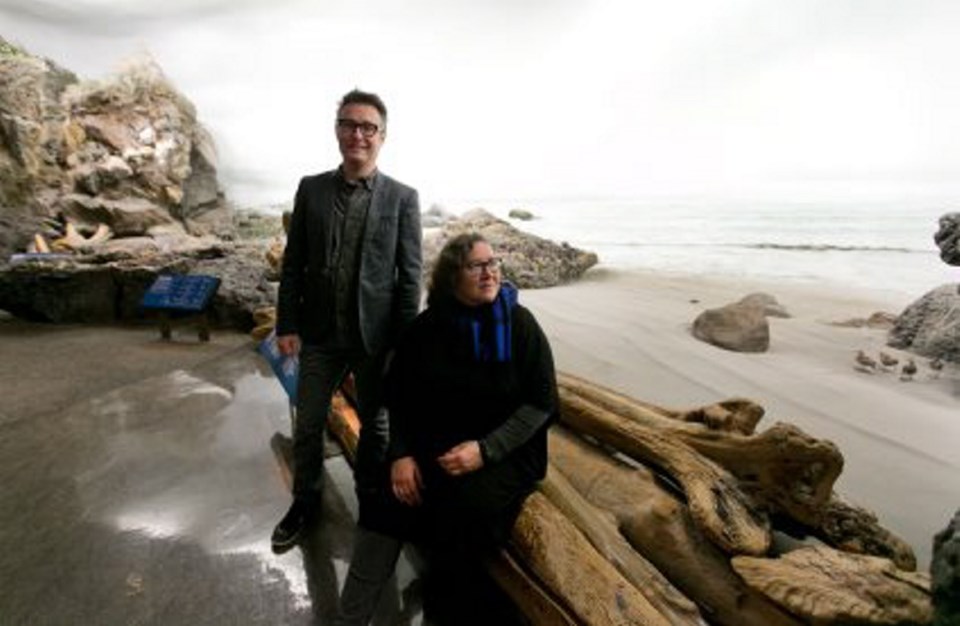What: Music for Natural History
Where: Royal B.C. Museum
When: Saturday and Sunday, two shows nightly at 7 p.m. and 8:30 p.m.
Admission: $25 at door or advance at royalbcmuseum.bc.ca
In the Royal B.C. Museum’s lobby — in the midst of chattering adults and one caterwauling tot — composer Tina Pearson imitated the sound of a tufted puffin.
“Err! Err!” exclaimed Pearson, in puffin-like fashion.
That’s just one of the nature sounds you’ll hear this weekend during performances of Music for Natural History. Sixteen vocalists and musicians, both professional and non-professional, will perform in spaces such as the forest and seashore displays.
Other animal sounds to be reproduced include those of the cougar, grizzly bear, screech owl, black-tailed deer, Roosevelt elk, golden-crowned kinglet, red-breasted sapsucker and the glaucous winged gull.
The intention is to give (human-produced) voice to taxidermied birds and mammals in the museum. The ensemble will also replicate the sounds of wind and surf. Music for Natural History is the brain-child of Pearson and co-composer Paul Walde. These acoustic performances will be live — nothing is pre-recorded.
The instrumentation includes cello, accordion, recorder, clarinet, saxophone, flute, violin, viola and ocarina. To get the correct sounds, unorthodox methods must sometimes be used. Violinists create squeaks using Styrofoam. Other noises are made using just the mouthpieces of recorders. Walde will recreate crashing surf using a bass drum turned on its side.
“Some of it’s hilarious,” Pearson said.
“It looks funny when someone is making a sea-lion sound,” agreed Walde.
“Arp, arp, arp, arp!” said Pearson.
It sounds like fun. Yet the 75-minute Music for Natural History concert has serious intent. Walde and Pearson say it is, in part, an attempt to reconnect people with their natural environment. In an urban environment, it’s easy to become detached from nature.
As well, these performances have a subtext: Due to climate change and other human-related causes, some of these natural sounds are beginning to disappear.
“It is tragic,” Pearson said.
There’s a long tradition of composers inspired by nature. Contemporary practitioners include John Luther Adams and Bernie Krause. Going further back, there are such compositions as Vaughan Williams’ Lark Ascending and Respighi’s The Birds.
Pearson and Walde met when they participated in a 2012 event called Site & Sound. For that, musicians, sound artists and poets were invited to perform at the museum after hours. The organizer then suggested Pearson and Walde collaborate once again, the result being Music for Natural History.
The concert has two components. There is The Elk Concerto, taking place in the forest diorama (the dome’s capacity for odd echoes provides an added dimension). Then there’s The Shoreline Operetta, which takes place beside the shoreline diorama.
Although the audience moves from one section of the museum to the other, they are mostly seated. Musicians move to and fro, playing their sounds and then departing. The music is memorized — no music stands allowed.
Music for Natural History was scored in an unconventional manner. For instance, the score contains suggestions on how to create certain sounds vocally. And it comes with sound samples to which musicians/singers are encouraged to listen.
Rather than reading a score, the approach was more reminiscent of a play script or dance choreography, which gives the performer a certain leeway.
“Some things are very tightly orchestrated, though,” Walde said. “For example, Tina does this cougar growl that scares the deer. And then that gets the squirrel upset.”
A warning for parents: it’s not a Disney-like evening out for the kids.
“We’re not trying to entertain people. It’s an art piece. It’s for your contemplation and enlightenment. It’s not meant to be, ‘Oh, that was a catchy tune,’ and you forget about it when you walk out,” Walde said.
His previous environmentally themed works include Requiem for a Glacier. For that 2013 performance, 50 musicians (many of them community players) journeyed to Farnham Glacier in the Kootenays. Requiem for a Glacier was intended to bring awareness of glaciers melting due to climate change. The text, in Latin, was a translation of a provincial government news release announcing the approval of Jumbo Glacier Resort.
At the most basic level, the composers hope Music for Natural History makes audiences more aware of their natural environment.
“If we open ears,” Pearson said, “then it’s been a success.”



